Related Research Articles

Aberdare is a town in the Cynon Valley area of Rhondda Cynon Taf, Wales, at the confluence of the Rivers Dare (Dâr) and Cynon. Aberdare has a population of 39,550. Aberdare is 4 miles (6 km) south-west of Merthyr Tydfil, 20 miles (32 km) north-west of Cardiff and 22 miles (35 km) east-north-east of Swansea. During the 19th century it became a thriving industrial settlement, which was also notable for the vitality of its cultural life and as an important publishing centre.

south Wales is a loosely defined region of Wales bordered by England to the east and mid Wales to the north. It has a population of around 2.2 million, almost three-quarters of the whole of Wales, including 400,000 in Cardiff, 250,000 in Swansea and 150,000 in Newport. Generally considered to include the historic counties of Glamorgan and Monmouthshire, south Wales extends westwards to include Carmarthenshire and Pembrokeshire. In the western extent, from Swansea westwards, local people would probably recognise that they lived in both south Wales and west Wales. The Brecon Beacons National Park covers about a third of south Wales, containing Pen y Fan, the highest British mountain south of Cadair Idris in Snowdonia.

Abercynon, is both a village and a community in the Cynon Valley within the unitary authority of Rhondda Cynon Taf, Wales. The community comprises the village and the districts of Carnetown and Grovers Field to the south, Navigation Park to the east, and Glancynon to the north.

Rhondda, or the Rhondda Valley, is a former coalmining area in South Wales, previously in Glamorgan, now a local government district, of 16 communities around the River Rhondda. It embraces two valleys – the larger Rhondda Fawr valley and the smaller Rhondda Fach valley – so that the singular "Rhondda Valley" and the plural are both commonly used. In 2001, the Rhondda constituency of the National Assembly for Wales had a population of 72,443; while the Office for National Statistics counted the population as 59,602. Rhondda forms part of Rhondda Cynon Taf County Borough and of the South Wales Valleys. It is most noted for its historical coalmining industry, which peaked between 1840 and 1925. The valleys produced a strong Nonconformist movement manifest in the Baptist chapels that moulded Rhondda values in the 19th and early 20th centuries. It is also famous for male voice choirs and in sport and politics.
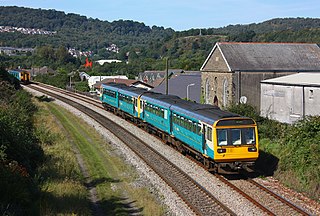
The Rhondda line is a commuter railway line in South Wales from Cardiff to Treherbert. The line follows the Merthyr line as far as Pontypridd, where it then diverges to continue along the Rhondda Valley.
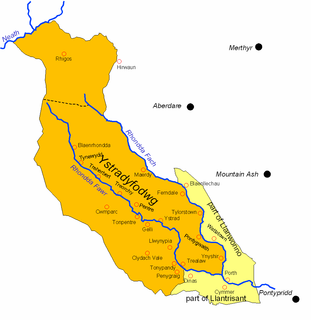
Ystradyfodwg or Ystrad Dyfodwg was an ancient upland parish in Glamorgan, Wales. It is believed to have been named after Dyfodwg a 6th-century saint or chieftain. The Parish included most of the area which would later be known as Rhondda named for the parish rivers, Rhondda Fawr and Rhondda Fach.

The River Rhondda is a river in South Wales with two major tributaries, Rhondda Fawr and Rhondda Fach.
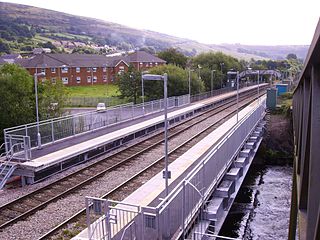
Ystrad is a village and community in the Rhondda Fawr valley, Rhondda Cynon Taf, Wales.

Bethania was a Calvinistic Methodist chapel in Aberdare, Rhondda Cynon Taf, Wales, which seated 550 people. Located near the centre of Aberdare, it had a somewhat concealed entrance and was approached up a long flight of steps.

Calfaria Baptist Chapel, Aberdare, was one of the largest baptist churches in the South Wales Valleys and the oldest in the Aberdare valley. The chapel had an ornate interior, including a boarded ceiling with a deeply undercut rose, while the balcony balustrading had a cast iron front with an intricate foliage design. These features were common in the Welsh chapels of the late nineteenth century. The organ was installed in 1903 at a cost of £850. It was played for the last time in 2012 by Robert Nicholls, during a Radio Cymru broadcast shortly before the closure of the chapel.

Siloa, Aberdare was the largest of the Welsh Independent, or Congregationalist, chapels in Aberdare. Services are held in the Welsh language. Established in 1844, Siloa is one of the few Welsh language chapels in the locality to remain open today. Siloa was notable for its long-serving ministers and in over a century there were only three pastorates, namely those of David Price (1843–78), D. Silyn Evans (1880–1930) and R. Ifor Parry (1933–64).

Hebron, Ton Pentre was one of the largest Baptist churches in the Rhondda valleys during their industrial heyday. As membership increased the chapel was rebuilt in 1889 and a schoolroom added in 1908.
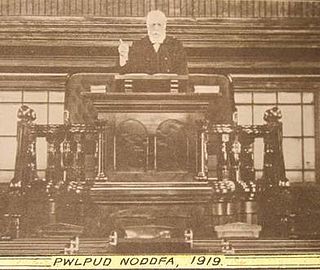
Noddfa or Noddfa Welsh Baptist Chapel, was located in Treorchy in the Rhondda Valley. It was one of the largest Baptist churches in the South Wales valleys, and one of the largest and grandest of all Welsh chapels.

William Morris, widely known by his bardic name, Rhosynnog, was the minister of Noddfa Baptist Church, Treorchy, South Wales from soon after its formation in 1868 until his death.
Ebenezer, Trecynon is an Independent (Congregationalist) chapel in Ebenezer Street, Trecynon, Aberdare, Wales. It was one of the earliest Independent chapels in the Cynon Valley and remained an active place of worship until 2009.

Coleg y Cymoedd is a further education college located at four main campuses across Rhondda Cynon Taf, and Caerphilly, Wales. Coleg y Cymoedd was formed after the merger of Coleg Morgannwg and Ystrad Mynach College in September 2013.

Nebo, Hirwaun was an Independent (Congregationalist) chapel in Merthyr Road, Hirwaun, Aberdare, Wales.
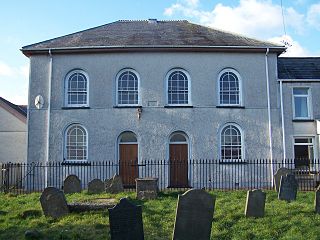
Salem, Robertstown is an Independent (Congregationalist) chapel in Bridge Street, Robertstown, Aberdare, Wales.
Moriah Aman, Cwmaman was a Welsh Independent (Congregationalist) chapel in Fforchaman Road, Cwmaman, Rhondda Cynon Taf, Wales.
Soar, Cwmaman was a Welsh Calvinistic Methodist chapel in Fforchaman Road, Cwmaman, Rhondda Cynon Taf, Wales.
References
- 1 2 3 4 "Pillars of Faith website" . Retrieved 21 January 2014.
- ↑ "Hanesion Crefyddol". Seren Cymru. 27 November 1868. Retrieved 22 January 2014.
- ↑ "Ystrad". Jan 20, 2007.